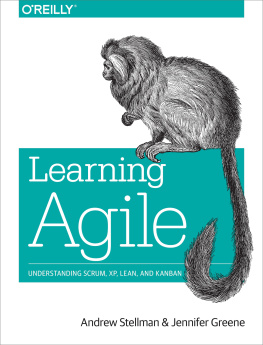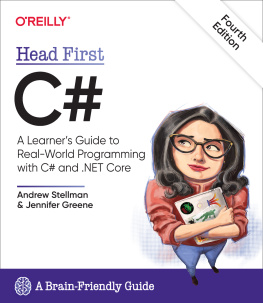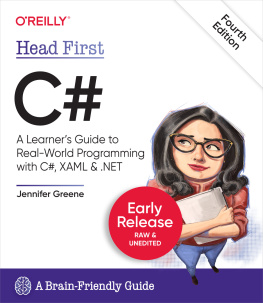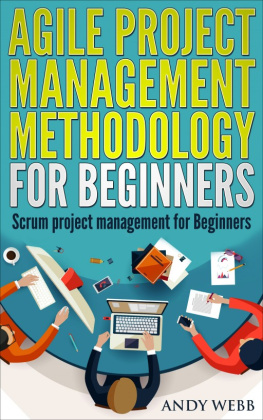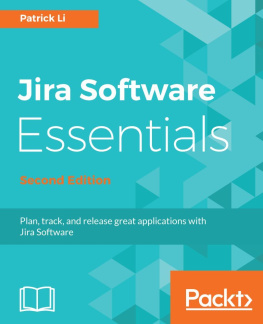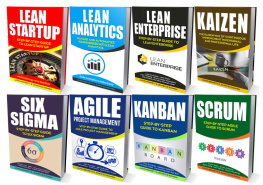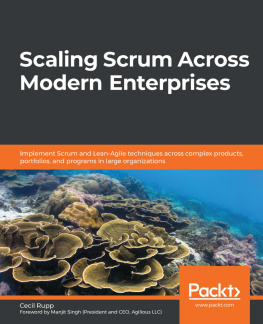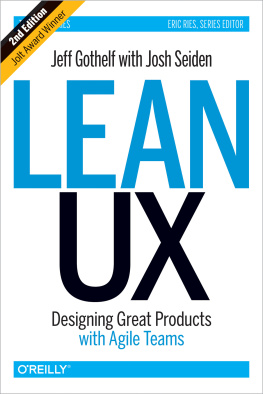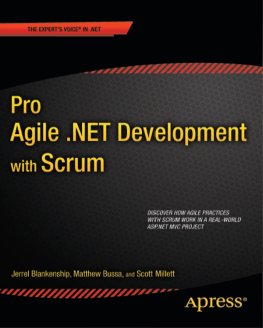Praise for Learning Agile
Another amazing book by the team of Andrew and Jennifer. Their writing style is engaging, their mastery of all things agile is paramount, and their content is not only comprehensive, its wonderfully actionable.
Grady Booch
IBM Fellow
The biggest obstacle to overcome in building a high-performance agile team is not learning how, but learning why. Helping teams discover the why is the key to unlock their potential for greater commitment and more creative collaboration. With a focus on values and principles Andrew and Jennifer have provided an outstanding tool to help you and your team discover the why. I cant wait to share it.
Todd Webb
Technical Product Leader at a global e-commerce company
While I was already sold on agile, what I learned from Learning Agile will help my efforts to sell agile across my organization. This book provides more than just an engaging way to gain a deep understanding of agiles principles and practices. The easily relatable stories will help make agile compelling to members across your team, so you can begin reaping its rewards.
Mark Denovich
Senior Business Consultant and Head of US development, Centriq Group
An excellent guide for any team member looking to deepen their understanding of agile. Stellman and Greene cover agile values and practices with an extremely clear and engaging writing style. The humor, examples, and clever metaphors offer a refreshing delivery. But where the book really shines is how it pinpoints frequent problems with agile teams, and offers practical advice on how to move forward to achieve deeper results.
Matthew Dundas
CTO, Katori
As an engineer, I always thought the problems that Agile practices help to solve are a direct hit for the industry. As it turns out, becoming Agile is hard; its more than just the practices. A piecemeal approach to Agile gives, as the the authors call it, better-than-not-doing-it results. If you are just getting started, or Agile is only better-than-not-doing-it, Andrew and Jennifer have a lot of practical advice on how to read between the lines of the Agile Manifesto and really become Agile.
James W Grenning
Founder of Wingman Software and co-author of the Agile Manifesto
Andrew Stellman and Jennifer Greene have done an impressive job putting together a comprehensive, practical resource that is easily accessible for anyone who is trying to get Agile. They cover a lot of ground in Learning Agile, and have taken great care to go beyond simply detailing the behaviors most should expect of Agile teams. In exploring different elements of Agile, the authors present not just the standard practices and desired results, but also common misconceptions, and the positive and negative results they may bring. The authors also explore how specific practices and behaviors might impact individuals in different roles. This book is a great resource for new and experienced Agile practitioners alike.
Dave Prior PMP CST PMI-ACP
Agile Consultant and Trainer
If you want to learn about any of the specific approaches to agile, you need to read the specific relevant books. That means you know what you want to do in advance. Not very agile of you, is it? What Andrew and Jenny have done is create an approachable, relatable, understandable compendium of what agile is. You dont have to decide in advance what your agile approach is. You can read about all of them, and then decide. On your way, you can learn the system of agile and how it works.
Johanna Rothman
Author and Consultant, www.jrothman.com
The culture of a software development team often has a greater impact than their expertise or tools do on the success of their project. Stellman and Greenes advice on how to transform an assortment of fragmented individual perspectives into a collaborative unit with shared values and practices should help any software manager regardless of the organizations official methodology. Their comparison of Scrum, XP, Lean, and Kanban techniques analyze the many ways in which Agile principles can be applied. The entertaining case studies illustrate the human dilemmasand the rewardsof learning to become Agile.
Patricia Ensworth
President, Harborlight Management Services LLC
Learning Agile is thorough, approachable, practical, and interesting. The values, principles, and methodologies explained in this book are thought-provoking and illuminating, and I look forward to applying them to my teams work.
Sam Kass
Software architect and tech lead in the financial sector
Andrew Stellman and Jennifer Greene have been there, seen that, bought the T-Shirt, and now written the book! This is a truly fantastic introduction to the major Agile methodologies for software professionals of all levels and disciplines. It will help you understand the common pitfalls faced by development teams, and learn how to avoid them.
Adam Reeve
Engineer and team lead at a major social networking site
Learning Agile
by Andrew Stellman and Jennifer Greene
Copyright 2015 OReilly Media. All rights reserved.
Printed in the United States of America.
Published by OReilly Media, Inc. , 1005 Gravenstein Highway North, Sebastopol, CA 95472.
OReilly books may be purchased for educational, business, or sales promotional use. Online editions are also available for most titles (http://safaribooksonline.com). For more information, contact our corporate/institutional sales department: 800-998-9938 or corporate@oreilly.com .
- Editor: Mary Treseler
- Production Editor: Nicole Shelby
- Copyeditor: Jasmine Kwityn
- Proofreader: Rachel Monaghan
- Indexer: Judy McConville
- Interior Designer: David Futato
- Cover Designer: Ellie Volckhausen
- Illustrators: Andrew Stellman and Jennifer Greene
- November 2014: First Edition
Revision History for the First Edition
- 2014-11-03: First Release
See http://oreilly.com/catalog/errata.csp?isbn=9781449331924 for release details.
Nutshell Handbook, the Nutshell Handbook logo, and the OReilly logo are registered trademarks of OReilly Media, Inc. Learning Agile and related trade dress are trademarks of OReilly Media, Inc.
Many of the designations used by manufacturers and sellers to distinguish their products are claimed as trademarks. Where those designations appear in this book, and OReilly Media, Inc., was aware of a trademark claim, the designations have been printed in caps or initial caps.
While the publisher and the authors have used good faith efforts to ensure that the information and instructions contained in this work are accurate, the publisher and the authors disclaim all responsibility for errors or omissions, including without limitation responsibility for damages resulting from the use of or reliance on this work. Use of the information and instructions contained in this work is at your own risk. If any code samples or other technology this work contains or describes is subject to open source licenses or the intellectual property rights of others, it is your responsibility to ensure that your use thereof complies with such licenses and/or rights.
978-1-449-33192-4
[LSI]
For Nisha and Lisa,
who have been very patient with us
Foreword
It seems that people always need something to debate. Was Van Halen better with David Lee Roth or Sammy Hagar? Pepsi or Coke? Lennon or McCartney? Cats or dogs? One such debate in the early days of agile was principles versus practices. Early agilists agreed on a set of principles enshrined in the Agile Manifesto, and many practices were shared across multiple agile approaches. However, there was fierce debate about whether a team should start by understanding the principles of agile software development or whether they should begin by performing the practices even before developing a deep understanding of why.

